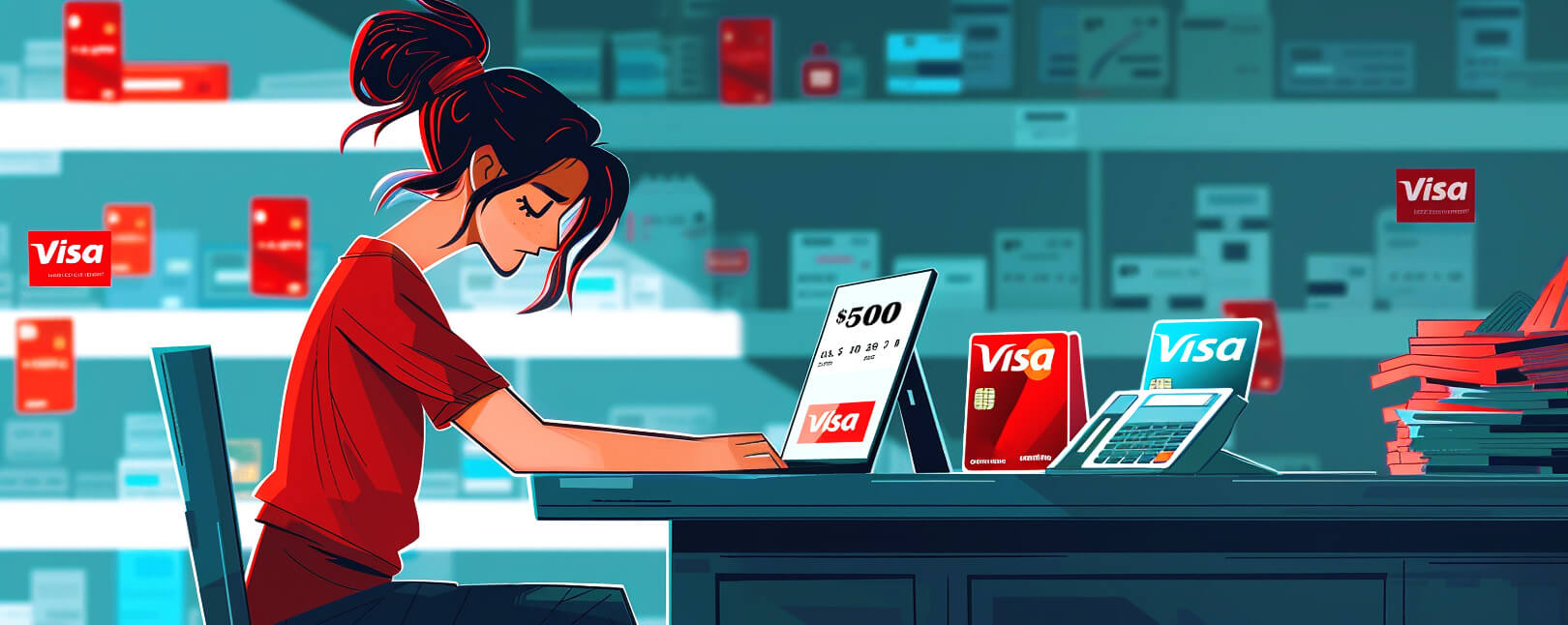Managing Disputes With Visa Resolve Online: The Key to Stop Chargebacks Before They Happen?
Chargebacks are a long-established problem in the card-not-present payment space. So, what are the card networks doing to try to address this problem?
They’ve taken steps including rule updates, process overhauls, and introducing new tech platforms to push back. Visa Resolve Online, or VROL, was one prominent example.
VROL is designed to help reduce the amount of incoming chargebacks you see each month. It’s also aimed at streamlining the dispute process and improving customer retention. Today, we’ll explore the benefits of operating on this platform, as well as some of VROL’s limitations.
What Is Visa Resolve Online?
- Visa Resolve Online
[noun]/vē • zə • rə • zälv • än • līn/
Visa Resolve Online, or VROL, is a web-based platform designed by Visa to make handling disputes for Visa card transactions easier and more efficient. It functions as a centralized hub where issuers, acquirers, and processors can manage card disputes in real-time.
With Visa Resolve Online, users can quickly track and manage Visa disputes, using the platform’s automated features that streamline many steps of the process. This helps everyone involved communicate and collaborate better, saving time and effort when resolving transaction issues.
In short, VROL helps ensure proper adherence to Visa dispute resolution rules, reducing the chances of mistakes. The platform provides detailed reports and analytics, which allow users to spot trends, identify problems, and improve how they manage disputes.
Learn more about Visa chargeback rules
What Does Visa Resolve Online Do?
Visa Resolve Online has been in place for more than two decades. However, it’s seen substantial upgrades over the years to make for a more robust platform.
Under current Visa dispute rules, all issuers and acquirers that are members of Visa must use VROL to carry out any of the following actions:
- 1. Respond to a retrieval request
- 2. Transmit chargeback, representment, arbitration, or compliance documentation
- 3. Make or process a pre-arbitration or pre-compliance attempt
- 4. File, withdraw, or appeal an arbitration or compliance case
In short: all documentation and communications related to a Visa chargeback must pass through Visa Resolve Online. This is why, if a buyer inquires about a transaction, the issuer should use VROL to try and collaborate with the merchant whenever possible. The dispute will be much more likely to result in a mutually agreeable resolution.
Visa Resolve Online Workflows: Allocation vs. Collaboration
The Visa Resolve Online workflow begins when a cardholder contacts their issuer to dispute a transaction, providing necessary details such as the transaction receipt, merchant details, shipping information, and delivery confirmation. The issuer then reviews this information to determine if the cardholder’s claim is legitimate. If so, they assign an appropriate reason code and file the dispute.
Based on the reason code, the dispute follows one of two primary dispute paths: allocation or collaboration.
Allocation
Allocation handles disputes related to fraud and unauthorized transactions. For disputes filed through this process, VROL will examine the conditions of the case and return an initial liability assignment in real-time. The at-fault party can either accept the real-time verdict or try providing additional evidence.
Collaboration
Collaboration typically deals with processing errors and consumer disputes. During this phase, Visa will request that the merchant provide additional information through VROL to resolve the dispute and prevent a chargeback. Otherwise, the dispute will proceed, and Visa will assign initial liability to the merchant.
Common QuestionWhat is Visa Claims Resolution?But, while VROL is not a new system, it saw a major overhaul with the introduction of the Visa Claims Resolution initiative back in 2018.
The aim here was to help merchants streamline the dispute resolution process and work in tandem to resolve claims faster and more accurately. Previously, disputes could take up to three months, from initial contact to final verdict. After VCR, Visa aimed to whittle that down to just 31 days in an effort to settle disputes within a single billing cycle.
Learn more about Visa Claims Resolution In either case, the merchant or acquirer can choose to accept or appeal the issuer’s decision regarding the dispute.
In the allocation workflow, the liable party can accept the decision or appeal to Visa. Through the collaboration workflow, the acquirer can challenge the chargeback during the representment stage by submitting necessary proof from the merchant to the issuer. The issuer then decides whether to reverse the chargeback.
What Data is Transmitted Through VROL?
In a nutshell, VROL transfers a wide range of data — such as transaction details, communication records, and supporting evidence — to be sure disputes are handled quickly and accurately. Here’s the information you can expect to be shared through VROL:
Basic Transaction Details
These include the transaction date, time, amount, and the merchant’s name and location. Having these details available helps verify the specifics of the disputed transaction and provides a clear reference point for all parties involved.
Transaction Receipts
Copies of the original transaction receipts are crucial for providing proof of purchase and validating the cardholder’s claim. Making sure these receipts are clear and detailed can significantly impact the resolution process.
Communication Records
Any interactions between the cardholder and your business, such as emails, chat logs, or phone call records. These records provide context and can clarify misunderstandings, supporting your case in the event of a dispute.
Shipping & Delivery Information
This includes tracking numbers, shipping receipts, and delivery confirmation details. In cases of disputes over non-delivery or incorrect delivery, this information demonstrates that goods were shipped and received as promised.
Proof of Services Rendered
Documentation like work orders, service agreements, or completion certificates. This helps confirm that the services were provided as agreed, which is crucial for resolving disputes over provision of services.
Cardholder Statements
Copies of the cardholder’s account statements showing the disputed transaction help track the transaction history and verify the cardholder’s report. These statements provide an additional layer of validation.
Chargeback Documentation
All documents necessary for initiating and responding to chargebacks, including reason codes and supporting evidence. This gives both issuers and acquirers the information needed to proceed with the chargeback process.
Evidence for Representment
If you challenge a chargeback, VROL transmits evidence such as additional transaction receipts, communication records, or proof of services rendered to the issuer. This evidence is reviewed to determine if the chargeback should be reversed.
Pre-Arbitration Documentation
Should a dispute escalate to pre-arbitration, all relevant documentation is transmitted to ensure a fair and thorough review. This includes any new evidence or arguments presented by either party.
Fraud Reports
Detailed fraud reports, including relevant data like IP addresses or suspicious activity logs, are transmitted in disputes involving suspected fraud. These reports are essential for identifying and addressing fraudulent transactions.
Consumer Dispute Information
Any additional data provided by the cardholder or your business that can help resolve consumer disputes. This might involve proof of refunds, cancellation confirmations, or extra customer service records, helping enhance the dispute-resolution process.
Take the next step to stop chargebacks.
VROL helps to ensure all parties have the necessary information to resolve disputes efficiently and accurately. Being well-prepared with detailed and organized documentation can lead to faster resolutions and better outcomes, ultimately enhancing trust and satisfaction in business transactions.
Are There any Shortcomings to Visa Resolve Online?
Visa Resolve Online is a powerful tool for managing disputes. But, it's important to note the platform’s limitations.
First, because VROL is a Visa-specific platform integrated into their Order Insight system, it doesn't handle non-Visa transactions. For instance, Mastercard uses its own platform called Mastercom, which operates under different requirements, procedures, and rules.
Additionally, while VROL can filter out some invalid chargeback activities, it doesn't eliminate all instances of friendly fraud. With friendly fraud accounting for three out of four chargebacks filed by cardholders, this remains a significant challenge for merchants.
Friendly fraud is particularly difficult to spot and stop because it often involves legitimate cardholders disputing legitimate transactions. Unlike traditional fraud, where unauthorized individuals use stolen credit cards, friendly fraud cases typically involve the actual cardholder claiming they didn't authorize a transaction, didn't receive an item, or that the product wasn't as described. This makes it challenging to differentiate between genuine disputes and fraudulent claims. Moreover, the subjective nature of these claims and the lack of concrete evidence can make it hard for merchants to defend against friendly fraud effectively.
VROL relies on hard transaction data and documentation to validate disputes. Thus, it can't always detect or prevent friendly fraud, which hinges more on the intentions and claims of the cardholder than on clear transactional discrepancies.
Getting Setup With Visa Resolve Online
Setting up Visa Resolve Online is a straightforward process, but it does require a few steps to make sure you are fully enrolled and able to take advantage of all the features of the platform effectively.
Step #1 | Contact Your Acquirer
The first step in getting set up with VROL is to contact your acquirer or payment processor. They will provide you with the necessary information and guidance on integrating VROL into your current payment processing system. Your acquirer acts as the intermediary between your business and Visa, helping to facilitate the setup process.
Step #2 | Meet the Technical Requirements
Your business needs to meet the technical requirements for using VROL. This may include having the appropriate software and hardware to integrate with the VROL system, as well as verifying that your internet connection is secure and reliable. Your acquirer can provide specific details about these requirements.
Step #3 | Enroll in Visa Resolve Online
To officially enroll in VROL, you must complete an enrollment form provided by Visa. This form typically requires information about your business, including your merchant identification number (MID), business name, and contact details. Your acquirer can assist you with filling out this form correctly.
Step #4 | Integration & Testing
Once you are enrolled, the next step is to integrate VROL with your existing systems. This might involve working with your IT team or a third-party vendor to ensure seamless integration. It’s essential to perform thorough testing to confirm that VROL functions correctly and that you can access all the features you need to manage disputes effectively.
Step #5 | Training & Support
Visa and your acquirer will provide training resources to help you understand how to use VROL. This training may include webinars, user guides, and one-on-one support sessions.
Step #6 | Start Managing Disputes
Once everything is set up and tested, you can use VROL to manage disputes. The platform will allow you to respond to retrieval requests, transmit chargeback documentation, and use all the features designed to streamline the dispute resolution process.
Getting set up with VROL helps in managing disputes more effectively. It also enhances your ability to provide better service to your customers by ensuring that all transactions are thoroughly reviewed and resolved in a timely manner.
How to Get the Most Out of Visa Resolve Online
Finally, let’s have a look at some best practices you should follow to get your business up to speed for Visa Resolve Online.
#1
|
Keep Meticulous Records
Every transaction. Every conversation. Photos. Shipping and tracking. Everything. You may need these details if you’re forced to dispute illegitimate transactions. Best to get in the habit naturally of keeping solid and well-organized records.
#2
|
Top-Notch Customer Service
Many disputes are due to consumer confusion or merchant mishandling. Make sure your merchant credentials are clearly stated, along with your policies. Always make yourself available for your customers. Remember, chargebacks can cost significantly more than the value of the initial transaction, so it’s wise to resolve issues before they are reported to Visa if possible.
#3
|
Use Fraud Filters
Criminal fraud could skip past your defenses while you are focused on resolving other issues. To help combat fraud, make sure you are using anti-fraud programs like address verification services (AVS), two-party authentication, and biometric identification, all backed by fraud filters to keep ahead of the curve.
#4
|
Double-Up Protections
Obviously, a Visa-centric program is not going to protect your business from chargebacks across all networks. It behooves a merchant to know what each card network and processor requires during the dispute resolution process, but that alone will not help you catch them all. A best practice in this situation is to learn and utilize every program offered by each card network.
#5
|
Know When You Need Help
Merchants don’t have the privilege to take it slow and easy when customers file transaction disputes. Strict timeframes, complex rules, and ambiguous dispute categories make it almost impossible to devote the right amount of attention to each case. Thankfully, third-party chargeback management companies are ideally placed to help businesses get a handle on disputes and win more chargeback cases.
Ask an Expert
It’s easy to become overwhelmed with chargebacks and all the processes invented to stop them. It seems like every week, some new statistic emerges to remind you that the problem has gotten way out of hand.
Well, don't worry. That’s what we’re here for.
Want to learn how Chargebacks911® can help you make the most of VROL to achieve better win rates and fewer disputes? Request your free demo now and find out.
FAQs
What is Visa Resolve Online?
Visa Resolve Online (VROL) is a platform that facilitates the efficient resolution of payment disputes by allowing issuers and acquirers to exchange transaction data and documentation. It streamlines the dispute process, helping to manage chargebacks, retrieval requests, and other transaction issues.
What is Visa Claims Resolution?
Visa Claims Resolution (VCR) is a framework designed to simplify and expedite the dispute resolution process for Visa transactions by reducing timelines and automating certain aspects of chargeback management. It aims to improve efficiency and accuracy in resolving transaction disputes between cardholders, issuers, and acquirers.
Is it safe to use Visa online?
Yes, using Visa Online is safe as it employs robust security measures, including encryption and multi-factor authentication, to protect sensitive information. These safeguards help to keep your transactions and data secure from unauthorized access.
How much does chargeback arbitration cost?
Chargeback arbitration can run between $500 and $1,000, depending on the card network involved. These fees cover the cost of having the dispute reviewed and decided by the card network's arbitration panel.
How long does it take for Visa arbitration to go through?
Visa arbitration can take anywhere from several weeks to a few months to complete, depending on the complexity of the case and the responsiveness of the involved parties. This timeframe includes submitting evidence, review, and final decision by Visa’s arbitration panel.














